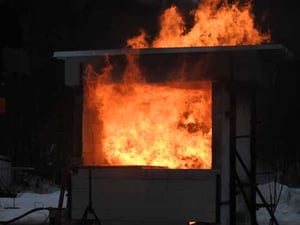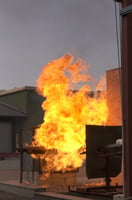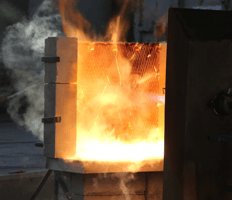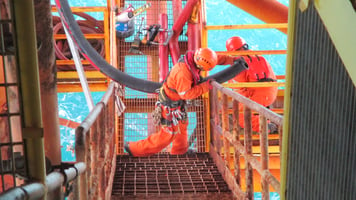When it comes to fire safety in extreme environments, there is no room for compromise. We are proud...
Passive Fire Protection material development for harsh fire requirements
As the offshore industry continues to push the limits when it comes to extending the life of assets and supporting operations in increasingly harsh conditions, the need for reliable and durable solutions that deliver proven passive fire protection (PFP) performance, has never been greater. The focus on technical safety in oil & gas production is continuously increasing, with an expectation that all products and solutions are tested, qualified and certified to relevant regulations and standards. Suppliers must commit to designing high performing, robust and reliable PFP solutions that will improve safety and protect people, equipment and critical infrastructure in demanding environments.
The focus on technical safety in oil & gas production is continuously increasing, with an expectation that all products and solutions are tested, qualified and certified to relevant regulations and standards. Suppliers must commit to designing high performing, robust and reliable PFP solutions that will improve safety and protect people, equipment and critical infrastructure in demanding environments.
Solutions must demonstrate excellent performance across a range of fire scenarios, often in conjunction with higher heat load, and document success through certification, type approvals and test reports that illustrate not only PFP properties, but also provide installation and handling information.
Testing advances and qualification of PFP solutions
During the development of any new PFP materials, manufacturers must ensure the solution is qualified against harsh fire requirements such as pool fire, hydrocarbon fire (HC fire) and jet fire. In recent years, the industry became gradually more aware that in reality, a jet fire has a higher heat load than allowed for in standard jet fire testing. This required the development of an extended jet fire test, also known as High Heat Flux (HHF) testing.
Fire classifications are characterized by heat fluxes around 150 to 200 kW/m2 with temperatures to approximately +1100 oC for HC fire, and around 250 to 300 kW/m2 with temperatures around +1200 oC for jet fire. HC or pool fires may occur when combustible liquids (oil, gas) leak from a pipeline, forming a fluid pit or reservoir which ignites. Fire integrity in these cases, is characterized using hydrocarbon (H) fire ratings, showing the material’s ability to resist fire and remain intact during a given time frame. For a product to gain a H fire rating, it must keep its integrity for 120 minutes.
The heat fluxes given for a jet fire are dependent on different boundaries such as type of fuel, a mix of fuel/oxygen, and flame size. ISO22899 describes a set-up with a pressurized gas release of 0.3kg/s giving a severe combination of erosive forces and heat. This can be highly destructive to some PFP systems, resulting in potential failure of the system to act as a barrier between areas. The test setup is sufficient when giving an indication of the performance of a wide range of PFP materials and systems, with the heat flux achieved limited to 250kW/m2.
The now recognized higher heat flux and temperatures of jet fires created the need for new HHF testing standards to be created. For both jet fire and HC fire testing, standards have been developed over decades and are well known to the industry, including ISO834, ISO22899, IMO FTP Code. HHF testing, often performed sequentially with HC fire testing, currently has no standardized test protocols or programs, and it is often left to individual suppliers to demonstrate HHF material or system compliance.
One company leading the way with HHF testing is Vipo. Vipo’s operation in Norway has created a large-scale bespoke HHF testing rig to assess its PFP materials in higher temperatures and heat fluxes. A larger than normal chamber measuring 3 x 3 x 2.7 meters with pressurized gas input to the same standard as stated in ISO22899, was constructed. For comparison, Vipo’s standard jet fire test chamber built and operated in accordance to ISO22899 measures 1.5 x 1.5 x 0.5 meters. For the HHF test, air is added to the chamber to increase the temperature, creating a high heat flux environment of 350kW/m2 with a temperature of approximately +1300 °C.
A new generation of PFP solutions
Vipo has developed a range of PFP solutions that include a flexible rubber layer to cover a wide variety of applications to prevent fire escalation between partitions, escape tunnels and routes. Due to their flexibility, they can be applied to any surface, flooring, walls, or roofing and mounted with a chemical or mechanical bond.
Seals offer a flexible connection between rigid metal sections. Capable of handling large displacements, they connect modules, maintaining a fireproof partition, absorbing misalignments and angular deviations, and eliminating concentrations of stress. Seals made using layers of rubber and other PFP materials are designed to also shield against both blast and fire, requiring them to be water and gas tight.
There are many types of pipe penetration sealing solutions available. Most solutions are rigid, preventing the operator from opening the seal for inspection without destroying it. This has created the requirement for a flexible, reusable solution that can withstand the toughest fire rating, leading to the development of our unique PPS (Pipe Penetration Seals) technology.
These are flexible seals consisting of several layers of tough and durable materials offering protection against fire, blast and weather. Requiring minimal space with a thickness of only 13mm, the wrap-around seal closes the pipe penetration and allows movement of the pipe during operation. Seals are tailormade to fit a wide range of different applications, geometries, and sizes, and are easily installed and dismantled with hand-held tools. Odin PPS is made in one piece with an overlapping joint and is typically fixed and secured with stainless steel hose clamps that are easy to remove for inspection, and can be reused, reducing wastage as seals are not damaged during the processes. The material used in our PPS can also be used in a wide range of other applications by bolting to a structure or customizing a solution to meet specific project requirements.
Our PPS are H0 and H60 fire rated, and jet fire certified according to ISO22899 for 250kW/m² jet fire, not exceeding temperatures of +180 °C for 65 minutes and with no integrity failure for 120 minutes. As no industry standard or certification has been established for HHF testing, a design verification report from DNV is issued to demonstrate successful performance, maintaining integrity for 120 minutes at a heat flux 350kW/m2 and temperatures exceeding +1300 oC.
Future developments
Vipo is in the midst of developing Riser PFP, a thin, lightweight, intumescent rubber based PFP technology able to withstand the requirements of HHF testing, in a bonded-to-pipe solution for rigid and flexible risers used on offshore oil and gas platforms. This new technology is capable of withstanding blast, jet and HHF fires, providing significant delays against temperature escalations in the risers. These delays offer time for people to evacuate, closedown critical equipment and for responders to gain control of the situation. This is a maintenance-free solution that can be applied on site, and due to the bonded-to-pipe properties, offers excellent corrosion, mechanical and wear protection to risers.






